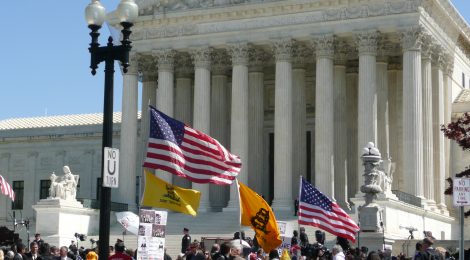
Making It Up As We Go: A Supreme Court Vacancy
February 13, 2016 might have capped the final year of the most divisive cohabitation periods between the Legislative and Executive branches in our country’s 240-year history. On that day, Antonin Scalia passed away and left a vacant seat on the Supreme Court. The controversy that has followed has set the gears of partisan politics into overdrive; Republicans are publicly determined to ignore the nomination by President Obama, and Democrats are impotently crying foul about the Republicans’ obstructionism. Nevertheless, history provides several examples of extended vacancies on the Supreme Court that suggest an amicable solution won’t be reached any time soon.[i]
As for the Constitution, Article II Section 2 states that the President “shall nominate, and by and with the Advice and Consent of the Senate, shall appoint … Judges of the supreme Court…”.[ii] What about the Senate, then? They take an oath to support the Constitution. Good start. However, the closest we get to anything related to their duties regarding the Advice and Consent for Presidential nominees is found in Article I Section 5. In the second paragraph there is a brief mention that “Each House may determine the rules of its proceedings…”.[iii] The rules of the Senate are the key, and there is no rule that says nominations must be reviewed in a timely fashion. In accordance with the rules of the Senate, both parties have in their own turn delayed and ignored Presidential nominees.
The list of both Judicial and Executive Branch vacancies due to inaction or blockage from Congress is long and distinguished. What is the historical context of this current battle? The Pew Research Center put together a good summary two weeks after Scalia died.
According to Pew, the middle of the 19th Century provides many examples of extended vacancies on the Supreme Court, ranging from 301 days in 1873-1874 to 841 days in 1844-1846. The record for the longest Supreme Court vacancy belongs to President Tyler, and there we find similarities in history to our current impasse. Tyler’s relationship with the Senate, and even his own Whig party was terrible, and his quarrels with the legislative branch held up the confirmations of his two nominees.[iv] Lincoln’s well-known and tumultuous presidency included three lengthy vacancies. Nixon had a long period of gridlock with the Senate and also had trouble filling a vacancy during his time in office. Starting in the 1970s, largely due to departing justices retiring contingent upon their successor being confirmed, things have sped up with an average vacancy of 55 days. Unfortunately, Justice Scalia didn’t get the opportunity to retire.
Both sides of the argument appear reasonable, but intractable. Not surprisingly, The Washington Post has had its fair share of commentary from both sides of the debate. Professor Somin of George Mason University illustrated his view that the Constitution doesn’t provide an easy answer, and instead focused on the right of Congress to provide their advice and consent based at least in part on reviewing a nominee’s judicial philosophy.[v] At the time of his article (February 17), he predicted the Senate could justifiably use that basis to refuse to provide their consent to the as-yet unnamed nominee from President Obama. Professor Somin’s article attempted to remove the controversy around considering judicial philosophy as part of the Senate process. However, the President nominated Judge Merrick Garland, a name earlier suggested by Republican Orrin Hatch, and one of the least controversial judges in the past century, thereby attempting to eliminate the judicial philosophy arguments in the Senate entirely.[vi]
Subsequently, the Dueling Deans’ article in The Boston Globe intended to show how two respected academics from polar opposite perspectives (Dean Martha Minow of Harvard Law School and Dean Deanell Tacha of Pepperdine Law School) could apply impartial reason, facts, and patriotic perspective to persuade the Senate to “value what you have” and consider the nominee.[vii] Relying on ethos due to their position and backgrounds, and employing solid logos and pathos, their focus was that the Constitution is unambiguous and that we, as a Nation, should treasure the “independent judiciary and rule of law.” They pointed to Article II as the source of the duty for both the President and Congress to appoint judges for the Supreme Court. Senators’ duties should be motivated by their oath of office and the need to uphold an orderly process as driving forces to consider the nominee. History may not have been a good basis for supporting their position, but certainly a desire for a less blatantly political nomination process might draw people to their position.
As epilogue to Professor Somin’s article and the two Deans, Professor Jonathan Adler of Case Western Reserve University also put pen to paper in The Washington Post after President Obama’s choice was made public.[viii] Adler, another contributor to the Volokh Conspiracy blog, chose to focus his argument on the distinction between the Senate’s duty to consider the nominee, and the wisdom of considering the nominee. He strenuously counters the Deans perspective, declaring there is no such obligation to consider the nominee. Additionally, he provides numerous examples of contradictory positions of many of the politicians over time, stressing the point that situational ethics drive behavior more than Constitutional duty.
So we have yet another example of politicians and academics trying to find solid justification in our rule of law system to come up with the right answers to the question, what must we do? In this case, the real answer is not as clear-cut as we would like. In our 240-year-old democratic experiment, the people who interpret the law often end up making it up as we go. If President Tyler’s administration was any indication, the fight over the late Justice Scalia’s Supreme Court scene is just beginning.
[i] DeSilver, Drew. “Long Supreme Court Vacancies Used to Be More Common.”Pew Research Center RSS. N.p., 26 Feb. 2016. Web. 01 May 2016.
[ii] “Article II.” LII / Legal Information Institute. N.p., n.d. Web. 01 May 2016.
[iii] “Article I.” LII / Legal Information Institute. N.p., n.d. Web. 01 May 2016.
[iv] “John Tyler.” The White House. The White House, 30 Dec. 2014. Web. 01 May 2016.
[v] “The Constitution Does Not Require the Senate to Give Judicial Nominees an up or down Vote.” Washington Post. The Washington Post, n.d. Web. 01 May 2016.
[vi]Michael. “Obama Chooses Merrick Garland for Supreme Court.” The New York Times. The New York Times, 16 Mar. 2016. Web. 01 May 2016.
[vii] “US Needs a Government of Laws, Not People – The Boston Globe.”BostonGlobe.com. N.p., n.d. Web. 01 May 2016.
[viii] “Again on the Erroneous Argument That the Senate Has a ‘constitutional Duty’ to Consider a Supreme Court Nominee.” Washington Post. The Washington Post, n.d. Web. 01 May 2016.




